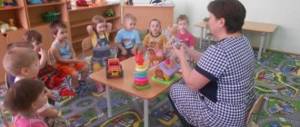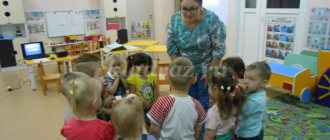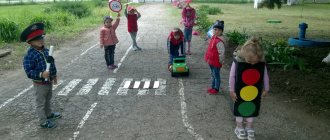Long-term planning of topics and goals for observations during a walk in the middle group
The teacher can choose a topic for observation on the topic “Autumn has come.” Children will learn to identify changes in the life of plants and animals. When completing the task, ideas about the autumn months are formed.
Topics and goals for observation during a walk in the middle group
In order to further consolidate knowledge, the teacher asks the children questions of the following nature:
- What time of year is it now? (Summer autumn Winter Spring).
- How did you guess that autumn has come?
- Who can list the characteristic features of this time of year?
- What does a person do in the fall?
- Why is it colder in December than in November?
- Is there wind in the fall?
- What month comes after February?
Children are interested in talking about animals; they listen very carefully about the weather when the teacher talks about their adaptation in the cold season. In addition, the teacher teaches the children how to work, telling them that when leaves fall out, they need to be removed. Observations in the middle group, a file cabinet with goals according to the Federal State Educational Standard, is a research process that fosters interest in the world around us, that is, in natural phenomena.
Some educational centers compile a nature calendar for preschoolers, “Features of Nature by Month,” compiled on the basis of federal statistical observation.
The goal of observing inanimate nature
Cards with goals for observing inanimate nature
During the lesson, the teacher invites the children to look at dry sand. The main goal of the lesson is to get acquainted with such a component of inanimate nature as sand.
Observation - take a small handful of dry sand on white or black paper. The teacher gives each child the opportunity to examine and touch the sand using a magnifying glass.
Then the following questions follow:
- What color is the sand? (Yellow or dark brown).
- What is sand made of? (Consists of small grains of sand).
- What can you call sand? (Loose).
Wildlife Observation Goal
Wildlife observation goal cards
Observation of wildlife involves the introduction of insects, such as ants. The course of the lesson is an examination of the anthill. The teacher asks preschoolers what it consists of. Next, the teacher explains to the children that twigs, bark, lumps of soil - all this was brought by little workers - ants. Small holes are passages. Ants scurry about, each one carrying something. Ants don't hurt anyone. They appear in early spring (March, April).
Formation of spatial thinking in preschool children
You can also consider another topic, for example, how to properly care for indoor plants. The teacher teaches children that flowers need careful care; they need to be looked after regularly, watered, and the leaves wiped. While doing the work, the teacher invites the children to take watering cans and water the plants.
How does an adult work?
Cards with goals for observing adult work
Children who attend a state educational center should appreciate the work of an adult. Therefore, during the lesson, preschoolers are invited to observe the work of a janitor. The main objective of the lesson is to consolidate knowledge about the janitor’s profession, what is included in his responsibilities, and how he can help the janitor.
Important! The teacher fosters a friendly attitude towards kindergarten staff.
During the observation process for preschoolers in the middle group, the teacher asks a riddle.
twisted, tied,
Tied to a stake
And he dances around the house. (Broom.)
Work in a corner of nature
Long-term planning of observations in junior kindergarten groups
A scientifically based approach requires the preparation of long-term planning in a preschool organization. This is a dynamic process that involves adjustments based on the results achieved. Organized observation in the younger group takes place under the guidance of a teacher whose activities are aimed at developing the independence of students. Children should notice changes in their environment when they go out for walks.
Preschoolers, under the guidance of a teacher, observe the life of flowers
Long-term planning is divided into the following:
- strategic, which is based on the educational program;
- tactical, based on the institution’s annual work plan.
Appearance of vegetation
In preschool institutions, thematic planning is used, which is compiled for 1-2 weeks, and all the material studied is selected in accordance with the theme of the week. When drawing up an observation plan, the age characteristics of the pupils are taken into account. Long-term planning should form the unity of goals, forms, and methods of the educational process. The systematicity and consistency of the plan ensures that students master the material.
Methodological recommendations for organizing and conducting observations of natural objects
Purposeful perception of objects and phenomena of living and inanimate nature is called observation. Teachers use techniques that activate students’ perceptions, ask questions, offer to examine, touch, and compare.
Observation allows you to show natural objects in their natural environment. Understanding the relationships in the environment develops observation skills and the ability to notice features. This type of activity fills the baby with aesthetic and emotional impressions. Direct interaction with the natural environment ensures the accumulation of vivid, memorable information about the world.
Research activity on the lawn
Observation involves determining the whole by individual characteristics: how to determine the degree of ripeness of fruits by color, by the fallen leaf of which plant it comes from. The teacher organizes frontal or group activities.
Note! Tasks and objects are determined in accordance with the program and work plan. The teacher chooses the type of observation: episodic, long-term, final.
You should think about the correct placement of the object so that it is clearly visible from different points. The necessary items, napkins, magnifying glass, thermometer are prepared in advance. The implementation of the assigned tasks will ensure the mental and speech development of preschool children.
Temporary plan of observations in the 2nd junior group
The total duration of children's stay in the fresh air should be at least 3–4 hours, including morning and evening walks. The structure of the walk consists of five components:
- observation;
- games;
- individual work;
- work activity;
- independent activity.
In the technological map of walks, observation carries the main educational load. Each item takes from 7 to 15 minutes, the order may vary. In winter, the duration is reduced. In unfavorable weather conditions, a walk is replaced by observing natural phenomena through the window, and the motor mode is implemented indoors.
We met fairy-tale characters while walking
The observation plan for a walk in the junior group in September includes the following topics:
- “Butterfly” - 8-10 minutes;
- “Flowers in a flowerbed” - 6-8 minutes;
- “Sparrows” - 8-10 minutes;
- “Pets (cat)” - 6-8 minutes.
The attention of younger preschoolers is attracted by bright, moving objects. The first observations are made on animals, then they move on to plants. The object can be the work of a janitor, seasonal clothing, weather changes. To attract the attention of pupils, surprise moments are used. Often, assistants are puppet theater characters who suddenly appear and ask questions, activating cognitive processes.
Important! Observation requires attentiveness, so adherence to time limits is mandatory.
The plan can include an excursion that has a narrow thematic focus, but for younger groups it is carried out indoors or on the playground. In this case, more time is allocated for observation.
Theoretical aspects of organizing observations in preschool educational institutions
In accordance with the Federal State Educational Standards of preschool educational institutions, the cognitive development of pupils is carried out in the form of games, experiments, projects, and examination. A peculiarity of younger preschoolers is that observation as a personality quality is not yet sufficiently developed. The observation structure consists of the following parts:
- beginning - creating a favorable mood;
- the main part is information about the object, phenomenon;
- completion - summing up.
Project "Pathfinder"
Organizational requirements are as follows:
- the assigned tasks are cognitive in nature;
- select a small amount of knowledge so that accumulation occurs gradually over repeated meetings with the object;
- every time children receive a portion of new knowledge;
- activate speech development;
- the techniques used should arouse interest in knowledge.
GCD for drawing on the topic “Vase with flowers” in preparatory groups
For younger groups, discriminating observation is recommended. Before meeting with the object, preparatory work is carried out.
The teacher prepares children to observe flowering bushes
If a butterfly is chosen as an object, then first they look at pictures, draw an insect, and read works of art. Students should get a general idea of the butterfly. In the future, the teacher uses various techniques to identify new signs of the object, features of existence. The work is carried out systematically and gradually. It ends with a generalization of knowledge and summing up. Result: the kids learned to recognize an object and distinguish it from others.
In the younger group, short-term observations are carried out, since it is difficult for children to maintain attention on one subject for a long time.
Observation is used not only during walks, but also when conducting educational activities as part of a lesson. The notes reflect the methods used.
Card index of observations and work in a corner of nature in the middle group
There are certain tasks that need to be completed to consolidate general knowledge in the middle group. For example, children are introduced to various plants in a corner of nature. This topic actively develops the child’s cognitive interest in the world of indoor plants.
The close proximity of children to indoor plants allows you to organize at any time:
- long-term observations of plants,
- organization of labor for caring for indoor plants;
- lesson system.
Note! Preschoolers in the middle group observe events more than carry out the teacher’s instructions. Therefore, this pattern of interaction with nature is crucial.
The children hear and absorb the gentle conversation between an adult and plants. They like it when the teacher calmly explains how to care for the flowers. When they see the teacher’s actions, preschoolers begin to willingly take part in them.
The next stage is when the teacher and children act in pairs, but priority remains with the adult, which is expressed in the formula: “I do it - you help me, you are my assistants. We take care of our pets together!”
How does the stage of labor organization take place in nature:
- living objects are observed, their condition and well-being are revealed, the missing conditions for a full life and necessary labor operations are determined;
- The final observation allows us to qualitatively assess the usefulness of the habitat for living objects.
Basic methodological recommendations on how to properly organize and conduct observations
A preparatory lesson on observing plants in a corner of nature consists of the following components:
- external features of the structure of plants are considered;
- the methods of their functioning are observed;
- children get acquainted with the conditions of the external environment (sometimes teachers organize an excursion);
- the dependence of the state of the object on the presence or absence of necessary conditions is revealed.
Studying geometric shapes in classes in groups of preschool educational institutions




